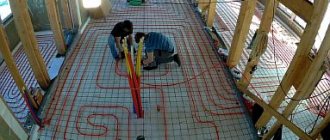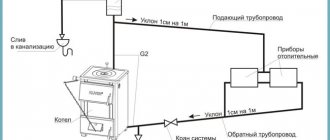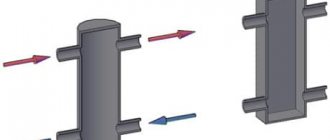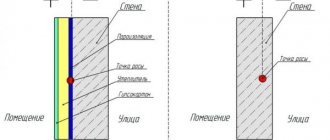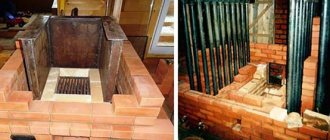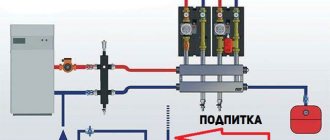Is it possible to have a heated floor in a greenhouse?
In winter, you cannot do without heating greenhouses. Various heating systems are used, but the most efficient and economical are heated floors. They create the necessary microclimate and evenly warm the soil.
Installing a heated floor in a greenhouse has many advantages:
- allows you to grow plants in any season;
- ensures rapid seed germination;
- leads to accelerated development and early fruiting of plants;
- creates suitable conditions for growing the most heat-loving crops;
- does not dry out the air and does not burn oxygen;
- reduces the risk of burns on leaves;
- reduces energy consumption.
In greenhouses with heated floors, conditions are created for crops to bear fruit all year round.
Methods for heating soil
The main task of heating the soil in a greenhouse is to provide the desired temperature for the plants. It is important that the earth does not dry out when heated, so it is recommended to use combined heating.
To heat greenhouses, you can use different systems - warm floors (water, electric, infrared) or air heating .
Water floor
A warm water floor is a multilayer structure in which each layer plays its own role. The main element is a pipeline, through which coolant circulates. Pipes are made of metal, polymer and polycarbonate.
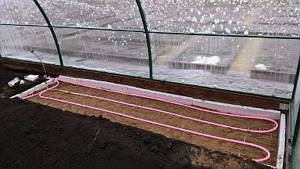
The floor pipeline is laid according to different patterns: “snail” or “snake”, and is connected to the manifold group, it is connected to the power source - boiler, boiler or central heating.
The advantages of hydrofloors in a greenhouse include uniform heating of the surface and vertical distribution of heat, which has a beneficial effect on plants. In addition, the floor water system is economical to operate and does not take up useful space.
The main disadvantage of such floors is the loss of room height due to the multi-layer structure of the “pie”. In addition, installation will not be cheap, since it will require the purchase of heating equipment and a pumping unit.
Electric floors
Electric floors - as the name suggests, they are powered by electrical energy. Due to high electricity tariffs, such models are rarely installed in greenhouses, although the installation itself is much simpler and more economical than water heating.
Electric floors are:
- Cable - a cable laid on the floor in a “snake” or “snail” pattern. The installation process is similar to laying a water floor.
The advantages of cable electric floors are durability, low cost and uniform heating. Disadvantages: electricity costs, labor-intensive installation.
- Cable mats - their difference from cable floors is that the wire is fixed to the grid according to a certain pattern, so the installation process is much easier.
- Infrared - carbon-coated film with a waterproof coating. The floor is easy to install and does not require screed. Emits heat in the form of infrared waves. Since the thermal efficiency of the infrared sheet is not high, the film is laid to a depth of no more than 15 - 20 cm, so there is a risk of mechanical damage during excavation work. The advantage of such systems is uniform heat distribution and energy savings.
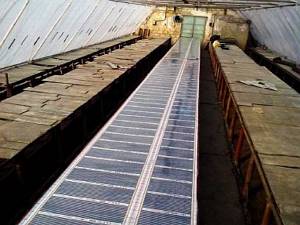
To adjust electric floors, a thermostat with a sensor is required, this makes the adjustment process automatic.
The main condition for electric heating in a greenhouse is the presence of nearby electrical networks.
Air heating
Air heating is considered a simple way to heat greenhouses. It is not difficult to arrange such a structure yourself; in addition, it does not require a large investment of capital. But this model is only suitable for the spring-autumn period; for winter its warmth is not enough.
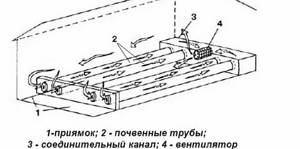
The principle of operation is the accumulation of heat that enters the greenhouse per day. The battery is a clay layer (200 mm); it is located under the plant cover.
The process looks like this:
- air masses move through asbestos pipes (100 - 200 mm in size) under the influence of a small fan;
- due to the gravity of the day, the air gives off heat through the walls of the pipes to the clay;
- at night - it transfers the accumulated heat to the beds.
To increase heating efficiency, thermal insulation material is placed under the clay.
This system can be operated in winter, but then it needs improvement and investment. To do this, you need to place a heater in the room - a gas or wood stove. The heat from it will pass through the pipes into the soil.
Bioheating
Bioheating is an economical method of maintaining the desired temperature level in a greenhouse. It is based on a biomaterial, the decomposition of which releases heat:
- weed clippings or fallen leaves;
- animal waste;
- sawdust.
In order to simultaneously maintain the temperature of the soil and air in the greenhouse at the desired level, it is recommended to install combined heating.
The disadvantage of such heating is the low temperature (+25), as well as the inability to regulate the degree of heating.
Air heating
There is a simple way to heat the soil in a greenhouse with air, which you can do with your own hands and without large financial investments. True, it is more suitable not for winter conditions, but for use in spring and autumn. The essence is the accumulation of thermal energy entering the structure during the day. The battery is a layer of clay 200 mm thick, laid under the plant soil cover. The diagram of an air heated floor is shown in the figure:

Air moves through asbestos pipes with a diameter of 100-200 mm, stimulated by a low-power fan installed in a common collector. During the day, heat from the air is transferred through the walls of the pipes to the clay cushion, and at night the beds receive heat from it. To increase efficiency, thermal insulation material, such as foam, should be placed under the clay.
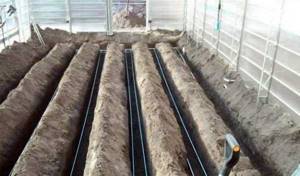
Advice. To install air heating in a greenhouse, instead of asbestos-cement pipes, you can use plastic sewer pipes of the same diameter. Any low-performance fan with a power of 25-50 W will do.
The proposed system can be improved to work in winter, but this will incur costs. It is necessary to install any suitable air heater inside the structure: a wood stove, gas or electric convector. The heat it generates will flow into the laid pipes, and from them to the soil and plants.
There is a more original way to heat the soil in a greenhouse - using flue gases from a wood-burning stove. The latter is installed in a deep pit, and the chimney pipe is buried under the beds, after which it goes vertically upward outside the building. The body of the furnace heats the air in the greenhouse, and the flue heats the soil. Below is a diagram of such a combined heating system:

The disadvantages are: the pit takes up a significant usable area of the greenhouse, it is inconvenient to heat the stove, and the temperature of the pipe is too high and it must be dug deeper, approximately half a meter into the ground. But the costs are minimal; to warm the soil in a greenhouse, a simple metal potbelly stove made by yourself is suitable.
Which heating system to choose and why
When choosing a warm floor for a greenhouse, you need to take into account not only your financial capabilities, but also the characteristics of the greenhouse space and its location. In addition, an important indicator is the cost of the coolant.
If there is a source with hot heat supply nearby, the choice suggests itself in the direction of a water floor. Even if there is only cold water, this option is preferable, because it is enough to install an inexpensive water heater.
If there is no water supply, and if there is a power supply nearby, you should choose electric floors. Cable models are recommended for heating large greenhouses. To effectively heat the soil, the power of cable systems must be at least 75 watts per m2. If the greenhouse is small, then you can lay the film, since it can heat a small room, and its installation is not difficult.
More often, electric heating is used where a multi-tariff meter is installed, then the cost of heating the greenhouse at night will be less.
Heating the soil in a greenhouse
